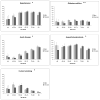Multiplicity of risk factors in ischemic stroke patients: relations to age, sex, and subtype--a study of 2,505 patients from the lund stroke register
- PMID: 24556909
- PMCID: PMC6157603
- DOI: 10.1159/000357150
Multiplicity of risk factors in ischemic stroke patients: relations to age, sex, and subtype--a study of 2,505 patients from the lund stroke register
Abstract
Background: The prevalence of risk factors for ischemic stroke may vary between different groups of stroke patients. We examined the distribution of individual well-established risk factors as well as the multiplicity of risk factors in different age groups and among subtypes.
Methods: In the Lund Stroke Register, we consecutively enrolled 2,505 patients with first-ever ischemic stroke from 2001 to 2009 and registered hypertension, diabetes mellitus, heart disease, current smoking, hypercholesterolemia as well as stroke subtype.
Results: Among young patients (<55 years), at least 50% had ≥2 risk factors and 20-25% had ≥3 risk factors. In patients aged 55 years or older, the proportion with ≥2 risk factors was 70-80% and with ≥3 risk factors 35-45%. Men and women had a similar burden of risk factors. Approximately 50% of the cases classified as cardioembolism (CE) and large artery atherosclerosis (LAA) had ≥3 risk factors, which was significantly more than the other TOAST (Trial of Org 10172 in Acute Stroke Treatment) subtypes (CE p < 0.001, LAA p = 0.001).
Conclusions: The prevalence of well-established risk factors is similar among young and old stroke patients with large proportions (50-80%) having ≥2 risk factors. Even though the prevalence of well-established risk factors differs between pathogenetic subtypes, these risk factors as well as the multiplicity of risk factors seem to be of clinical importance in all major subtypes of ischemic stroke.
© 2014 S. Karger AG, Basel.
Figures



References
-
- Rothwell PM, Coull AJ, Giles MF, Howard SC, Silver LE, Bull LM, et al. Change in stroke incidence, mortality, case-fatality, severity, and risk factors in Oxfordshire, UK from 1981 to 2004 (Oxford Vascular Study) Lancet. 2004;363:1925–33. - PubMed
-
- Béjot Y, Osseby GV, Gremeaux V, Durier J, Rouaud O, Moreau T, et al. Changes in risk factors and preventive treatments by stroke subtypes over 20 years: A population-based study. J Neurol Sci. 2009;287:84–8. - PubMed
-
- O’Donnell MJ, Xavier D, Liu L, Zhang H, Chin SL, Rao-Melacini P, et al. Risk factors for ischaemic and intracerebral haemorrhagic stroke in 22 countries (the INTERSTROKE study): A case-control study. Lancet. 2010;376:112–23. - PubMed
-
- Goldstein LB, Bushnell CD, Adams RJ, Appel LJ, Braun LT, Chaturvedi S, et al. Guidelines for the primary prevention of stroke: A guideline for healthcare professionals from the American Heart Association/American Stroke Association. Stroke. 2011;42:517–84. - PubMed
-
- Lim SS, Vos T, Flaxman AD, Danaei G, Shibuya K, Adair-Rohani H, et al. A comparative risk assessment of burden of disease and injury attributable to 67 risk factors and risk factor clusters in 21 regions, 1990–2010: A systematic analysis for the Global Burden of Disease Study 2010. Lancet. 2012;380:2224–60. - PMC - PubMed
Publication types
MeSH terms
Grants and funding
LinkOut - more resources
Full Text Sources
Other Literature Sources
Medical

